In this guide, we’ve shared real examples to help you see why SEO matters and how you can approach it in a practical way.
We’ve kept things straightforward—no unnecessary technical jargon—because we understand your expertise is in roofing, not digital marketing.
Our goal is to make SEO accessible, with easy-to-follow tips and realistic strategies that work for roofing businesses.
Whether it’s improving your website or optimizing your Google Business Profile, you’ll find actionable advice that you can apply right away to grow your business and stay ahead of the competition.
A Realistic Roofing SEO Guide
Make Your Website Fast-Loading
When someone’s looking for a roofing service, they’re not just comparing prices—they’re judging professionalism.
A slow, clunky website can make potential customers think twice about your business.
Roofing services are a big investment, so if your website feels outdated or takes forever to load, people might assume the same about your work. That’s not the impression you want to leave.
Your website should load in under 1 to 3 seconds—that’s the sweet spot. Anything slower, and you risk losing leads to competitors who’ve invested in a faster, smoother user experience.
Luckily, tools like Google PageSpeed Insights, Pingdom, and GTmetrix make it easy to check how your website performs. These tools will highlight what’s slowing you down, whether it’s oversized images, too many plugins, or something more technical.

Fix those issues, and you’ll not only improve user experience but also get a little boost in SEO rankings.
Make Your Website Mobile Responsive
Did you know that over 60% of searches now happen on mobile devices?
That means most people looking for roofing services are checking out your website on their phones. If your site doesn’t look good or work smoothly on mobile, you’re losing potential customers—simple as that.
In fact, you should prioritize how your website looks and feels on a phone even more than on a desktop.
The goal is to make it easy for users to find what they need, whether it’s your contact information, services, or reviews.
A clunky mobile site could push them straight to a competitor whose site feels more polished.
Here’s an easy way to check your site: open it on your phone.
Does it look good?
Can you navigate it easily?
If you want to dig deeper, use tools like usepastel.com to test how your site looks on different devices.
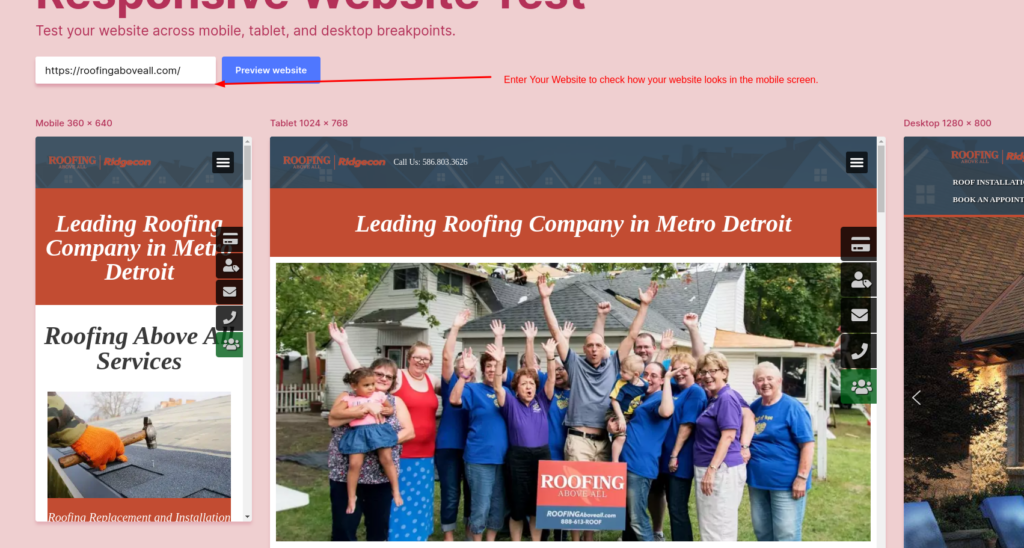
For a more practical check, ask a friend to open your site and a competitor’s on their phone.
Which one do they prefer?
Be honest with yourself about their feedback—it’s worth it.
Focus on Important On-Page SEO
Increase CTR with Good Titles & Meta Descriptions
Your title and meta description are like a billboard for your website. If they’re catchy and relevant, people are more likely to click. And here’s the thing: when more people click on your website, it sends a positive signal to Google.
Essentially, it tells Google that your website is preferred over others, which can help improve your rankings over time.
Take Braun’s Roofing as an example. They rank #1 for the keyword “roofing companies in Houston, Texas”, which is a high-traffic keyword with strong buying intent.
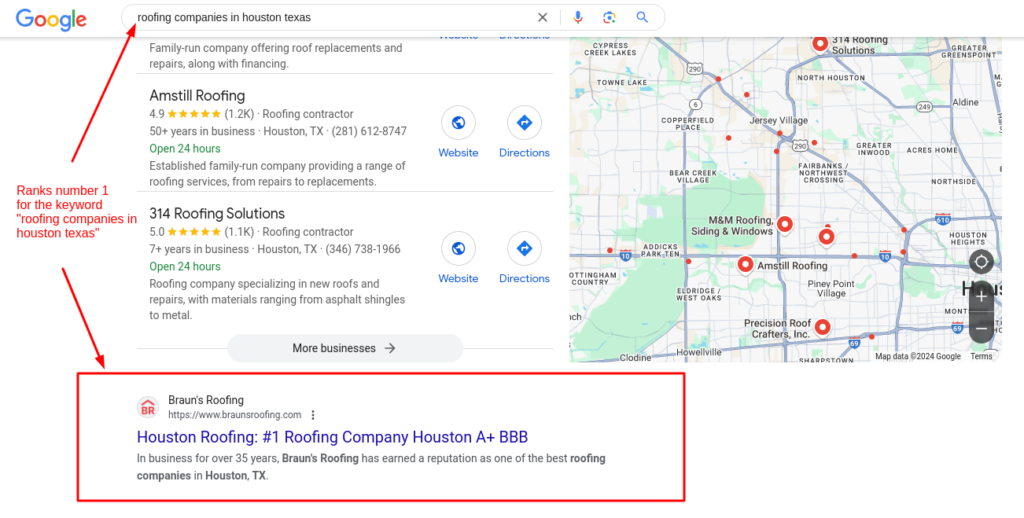
Their success isn’t just because they’ve been in business for over 35 years—it’s also because they’ve nailed their title and meta description.
The title immediately grabs attention with “#1 Roofing Company” and adds trust by mentioning the A+ BBB rating.
Meanwhile, the meta description reinforces their credibility and long-standing reputation. Together, these elements encourage potential customers to click.
If you want to replicate this for your roofing business, make sure your title highlights a key selling point—like years of experience, awards, or local expertise.
For the meta description, keep it short but focus on what sets you apart. These small changes can have a big impact on your click-through rate (CTR).
Proper Use of Keywords in Content
When it comes to SEO, using the right keywords in the right places is crucial for helping Google understand what your content is all about. But it’s important not to overdo it—keyword stuffing can actually harm your rankings.
You want to place keywords in areas like your title, meta description, paragraphs, headings, and even in the alternate text of your images. These are all spots that help search engines like Google figure out what your page is about.
Take a look at Braun’s Roofing landing page as an example. They’ve done a great job of incorporating keyword variations naturally—like “best roofing companies in Houston, TX,” “roofing contractor in Houston,” and “Houston’s best roofing pick.”
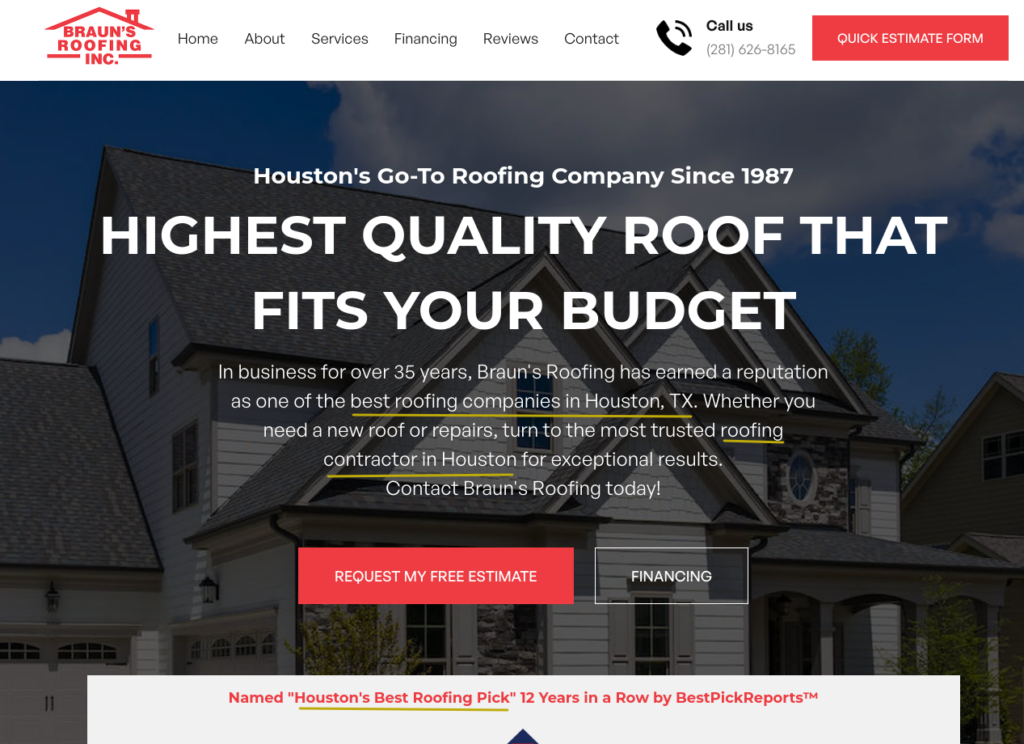
They use these phrases in a way that feels organic, not forced. If you can use keywords this way, your content will not only make sense to Google, but it’ll also feel more authentic to your readers.
Avoid cramming keywords in everywhere; it’s about balance and making your content flow naturally.
If you follow this approach, you’ll help Google better understand your page while still keeping things readable and engaging for your audience.
Enhance Engagement with Graphics: Images & Videos
Images and videos are powerful tools to engage your audience and make your roofing content more appealing.
For articles like “How to Maintain Your Roof,” use before-and-after images or a video showcasing roof repairs.
In a “Choosing the Right Roofing Material” article, add photos of different roofing materials or a video showing installation.
For “How to Spot Roof Damage,” images of common issues and a quick video on roof inspections can really help clarify your points.
Make sure your visuals are high-quality, relevant, and optimized for fast loading. The right images and videos can enhance understanding, keep visitors engaged, and boost your SEO.
Strategic Use of Internal & External Links
Internal links aren’t just helpful for directing traffic to your most important pages—they can also speed up the process of getting your new pages indexed by search engines.
By linking to a fresh page from other established pages on your site, you’re essentially giving search engines a map to find that content quicker.
For example, if you’ve added a new landing page for a roofing service, you can link to it from your blog posts or service pages.
Using keyword variations in your anchor text, like “affordable roofing solutions” or “expert roofers,” can help that page rank for those terms. Just be sure to keep the language natural—don’t use the same anchor text too often, or it can look spammy to search engines.
When it comes to external links, they can help you build credibility by connecting your site to trusted sources in the roofing industry.
Linking to authoritative websites shows that you’re engaged with the broader conversation and adds value to your content.
However, be careful when linking to competitors. If you’re trying to rank for a keyword like “roofers in Houston,” you don’t want to link to a direct competitor with the same anchor text.
Be careful when linking to competitors. If you’re trying to rank for a term like “roofers in Houston,” don’t link to a competitor using the same keyword. This could actually help them rank higher than you.
Instead, link to trusted, high-quality websites that aren’t in direct competition with you. This way, you can build your website’s authority while still benefiting from these valuable links.
Create Optimized and User-Friendly URLs
When it comes to URLs, simplicity is key. You want your URLs to be easy for both users and search engines to understand.
For example, instead of using a long, complicated URL like “/services/123456789,” try something straightforward like “/roofing-services” or “/roof-repair-houston.”
This not only makes it easier for users to know where they’re going, but it also helps search engines understand what the page is about.
Also, include relevant keywords in your URLs. For instance, if you’re targeting a specific service, like “roof installation,” make sure that’s part of your URL. But again, keep it clean and short—no need for extra words or symbols.
Focus on Off-Page SEO
Off-page SEO is all about building credibility for your roofing website by earning mentions and links from other websites.
One way to do this is through citation backlinks. These are profiles created on local directories like Yelp, Angi, or YellowPages.
When creating these profiles, make sure your business Name, Address, and Phone (NAP) information is consistent across all platforms. This consistency reinforces your brand’s legitimacy in the eyes of search engines.
To take things a step further, we analyzed a roofing company, BraunsRoofing.com, using Ubersuggest.
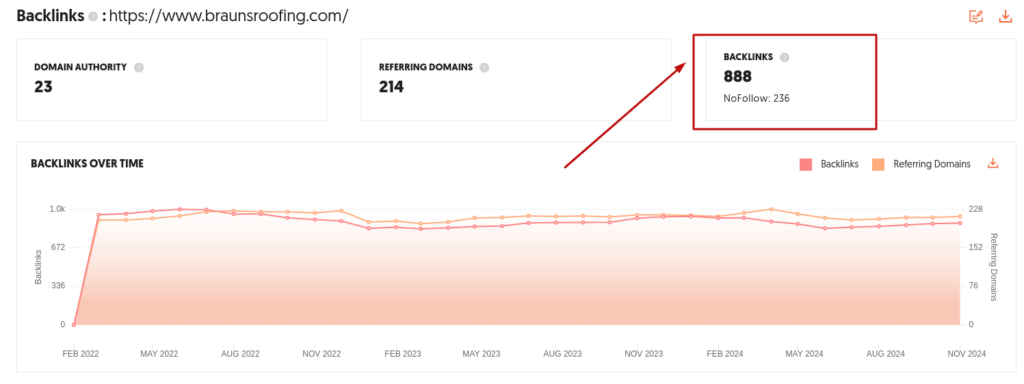
They have an impressive backlink profile with 888 backlinks from 214 referring domains. These backlinks come from various high-authority sources, such as USA Today and BBB.org, as well as niche directories like Homestead and YellowPages.
For example, their mention in USA Today, with a domain authority of 94, is a powerful signal to search engines. Such links not only improve rankings but also establish trustworthiness with potential customers.
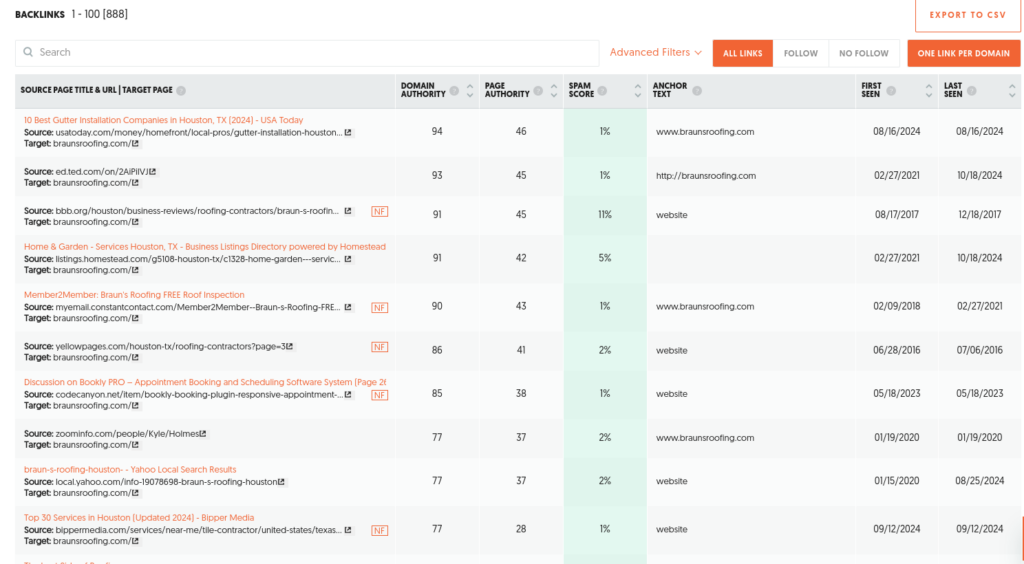
Interestingly, when you dive into their backlinks, you can see a mix of “follow” and “nofollow” links.
Both types are important in building a natural and diverse link profile. Tools like Ubersuggest or Ahrefs allow you to identify where these links are coming from, making it easier to replicate their strategy.
For instance, we found that many of their backlinks came from local directories, business reviews, and even blog mentions. This shows that even as a roofer, you can take simple steps, like reaching out to local sites or contributing guest posts to relevant blogs, to build similar backlinks.
By analyzing Brauns Roofing’s approach, it’s clear that you don’t need hundreds of backlinks overnight. Focus on replicating high-quality links first and gradually build your profile. These efforts, combined with local citations, can help your roofing business climb the rankings steadily.
Build Topical Authority with High-Quality Content
Building topical authority is about creating a library of high-quality content that covers your roofing niche comprehensively.
When you position your website as the go-to resource for all questions related to roofing, search engines like Google recognize you as an expert in the field.
This boosts your chances of ranking higher because your website becomes a trusted source for users seeking detailed and reliable information.
The first step is finding the right topics. Use tools like Ubersuggest, Ahrefs, or SEMrush to identify keywords relevant to your roofing services.
Combine this with Google’s autocomplete suggestions and the “People Also Ask” section to uncover additional questions your audience is searching for. The goal is to create content that answers every possible query someone might have about roofing.
For example, instead of writing just one general article about “roof installation,” you can dive deeper into the topic. Write separate articles like “How to Prepare Your Home for a Roof Installation,” “Different Types of Roofs for Residential Properties,” “What to Expect During a Roof Installation,” and “How Long Does Roof Installation Take?”
By covering multiple angles, you’re not only addressing user intent but also signaling to Google that your website is an authoritative hub for everything related to roof installation.
As you create this content, don’t forget to interlink your articles. If someone is reading about roof preparation, they might also be interested in understanding the timeline for installation or the types of roofs available.
Interlinking makes navigation easier for users and helps Google crawl your site more effectively. Over time, as you consistently publish content and build out your topical authority, you’ll notice your rankings improve because search engines trust that your site provides comprehensive, well-structured information.
Optimize Your Old Articles
Optimizing your old articles can often lead to surprising results. Sometimes, a simple refresh is all it takes to breathe new life into content that’s been sitting unnoticed.
Take the example of classicroofreplacement.com and their blog post about modified bitumen roofs.
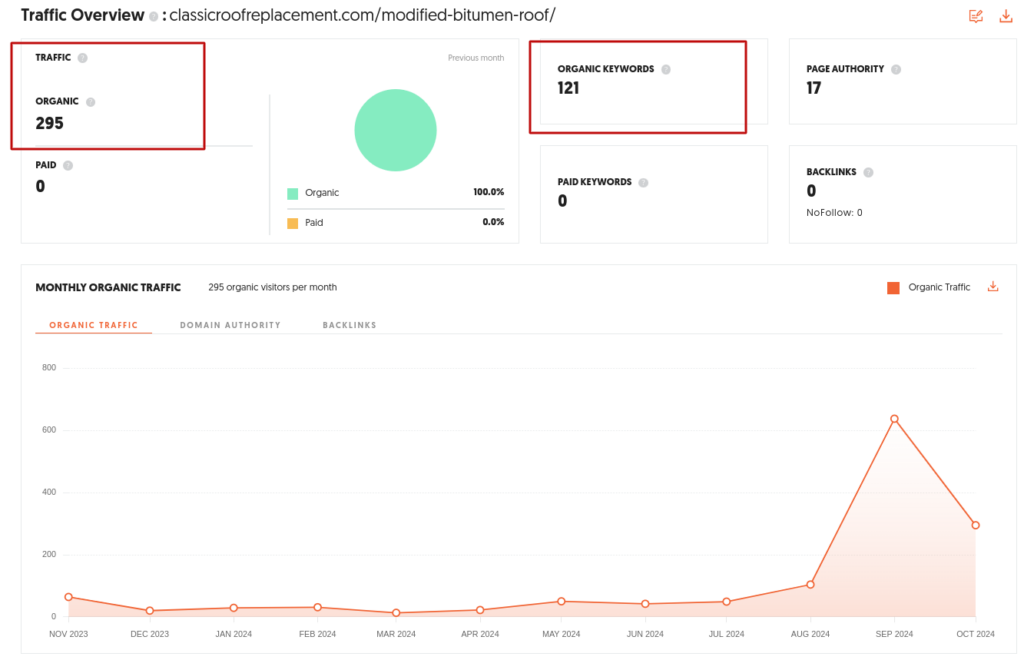
This single article pulls in about 295 monthly visitors from 121 keywords. However, while traffic increased in September 2024 compared to previous months, there was a noticeable drop in October. What’s interesting is that many of the keywords it ranks for are lingering at the bottom of the first page—positions 8, 9, or even lower.
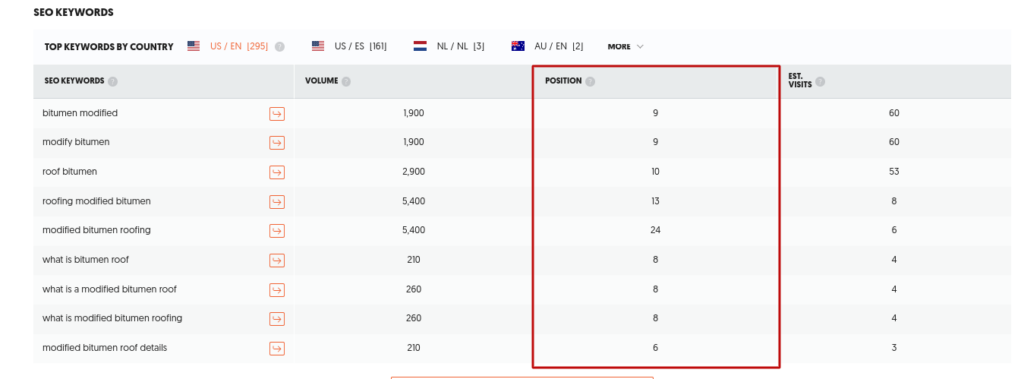
This presents a clear opportunity. By updating the article to better match the intent behind these keywords, adding fresh, relevant details, and ensuring the content feels current, it’s possible to push those rankings higher.
Even small improvements, like refining headings or expanding sections, can make a big difference. And with better rankings come more clicks, more traffic, and ultimately, better results. It’s a reminder that your old articles don’t just sit there—they have the potential to work harder for you, if you’re willing to give them a little extra attention.
Work On Your Google Business Profile
Working on your Google Business Profile is one of the most critical steps for improving local SEO.
In many cases, Google Maps listings appear higher in search results than websites in the regular search engine results pages (SERPs).
If you think about it, when you search something like “roofing company in Houston,” you’ll notice that the map pack with three local companies often comes before the websites.

Take Braun’s Roofing, for example—they rank well organically but don’t appear in the top three Google Maps results. This suggests their website is well-optimized, but their Google Business Profile still needs attention.
Another reason to focus on your Google Business Profile is the way people search today. Many users skip Google’s main search and go directly to Google Maps to find local services. This means that even if your website isn’t ranking at the top of the SERPs, you can still attract high-quality leads if your Google Business Profile is optimized.
If we talk about Braun’s Roofing again—they’ve been in business for over 35 years, which is longer than most of their competitors except for Amstill Roofing.
Despite this, Braun’s doesn’t appear in the top three Google Maps results. One major reason is reviews. Braun’s competitors, like Amstill Roofing and JC&C Roofing, have hundreds—or even over a thousand—reviews, while Braun’s lags behind.
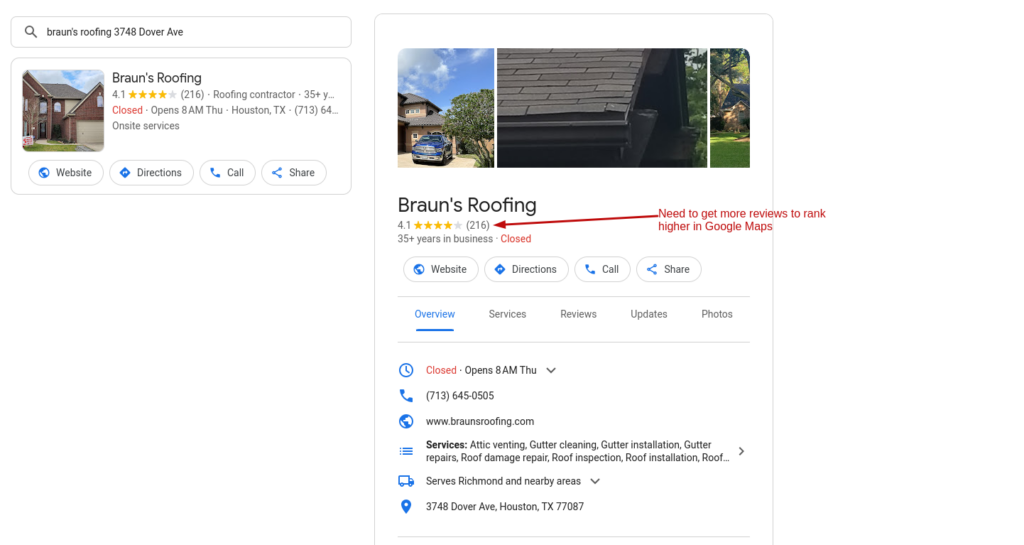
Reviews are one of the most critical ranking factors for Google Maps. Amstill Roofing, for instance, has a 4.9-star rating with over 1,200 reviews, and they’ve been in business for 50+ years.
JC&C Roofing, with a 4.8-star rating and 285 reviews, also secures a top spot. Even Precision Roof Crafters, with 326 reviews and 25+ years of experience, outranks Braun’s.
This shows that while longevity matters, reviews can make or break your ranking in Google Maps.
Encouraging your customers to leave reviews isn’t just about ranking higher; it’s about building trust.
If someone is deciding between three companies, they’ll almost always pick the one with more positive reviews. So, don’t just focus on website SEO—put equal effort into your Google Business Profile to capture those leads directly from the map pack.
Conclusion
SEO has become more important than ever for roofing companies. More people use Google today to find services than they did ten years ago, and this trend isn’t slowing down.
If you want your business to stay ahead of the competition, investing in SEO isn’t optional—it’s a necessity. Ranking for the right keywords, whether in Google’s organic search or in Google Maps, is how you ensure your company gets noticed by potential customers who are actively looking for roofing services.
At Roofing Web Design Agency, we specialize in helping roofing companies succeed with SEO. We focus on making sure your business ranks where it matters most—whether that’s in Google Maps or for the search terms your customers are actually using.
When done right, SEO doesn’t just improve your rankings; it helps you attract the kind of leads that turn into real jobs. The competition is fierce, but with the right strategy, your company can stand out and thrive.
